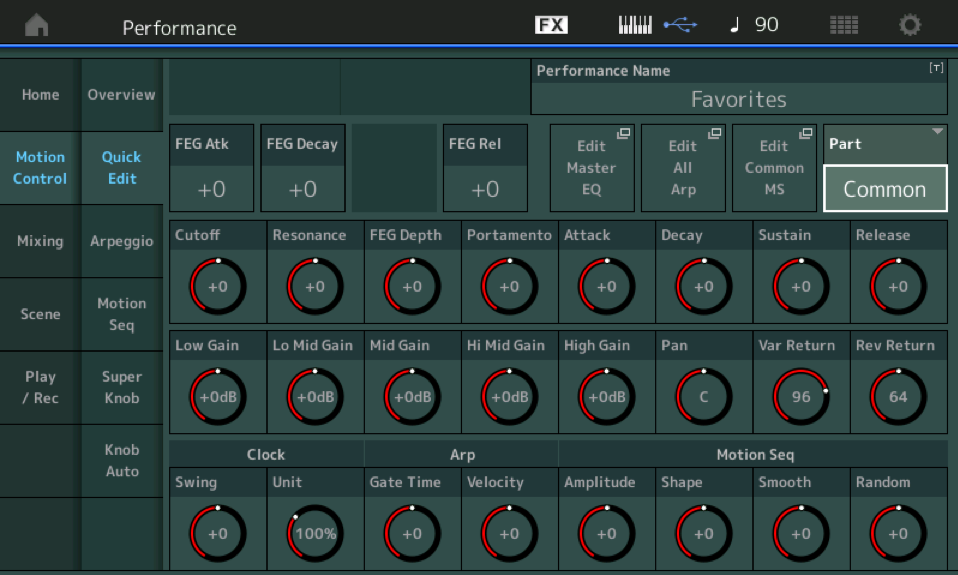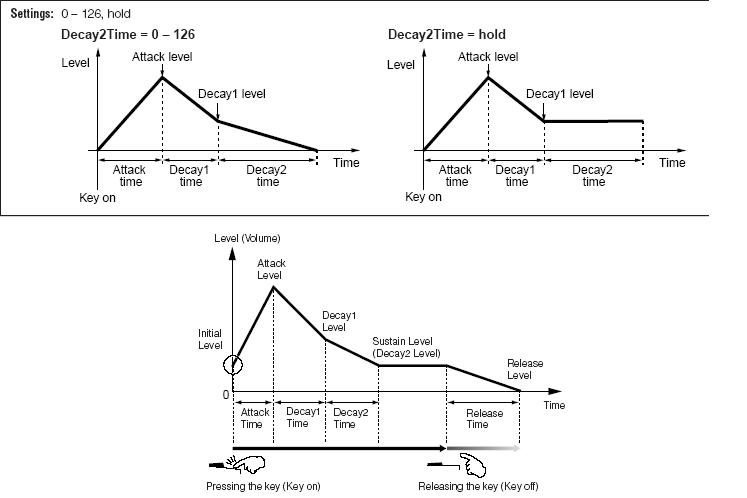]Hi ! can someone guide me as to how to increase or decrease the value of sustain without using a pedal
for ex in keyboards we can go to voice edit and increase or decrease voice sustain in settings menu
Go to the Part and edit the AEG or turn the knobs. Your 4 knobs above the sliders can be switched to a mode to control ADD(2)R. Press the button (above "ASSIGN" ) to the left of these knobs until EG/FX is lit green then turn knobs 1-3 to adjust the AEG.

Current Yamaha Synthesizers: Montage Classic 7, Motif XF6, S90XS, MO6, EX5R
I tried it in order to get sustain but could not do so can you please send a video showing the steps clearly
First, we should get on the same page. What Performance would like you adjust "sustain" for? Please pick a factory preset even if it isn't your final Performance so I can more directly help using the same Performance. Then you can transfer that knowledge over to your desired custom Performance if you are not already using a factory preset to start with.
I also say this because it makes slight differences in screens between FM-X (synthesized) and AWM2 (sampled).
There's not one way to get this accomplished. Scenes can also be used. Here's a video: https://www.youtube.com/watch?v=Y89spKQe2Lk
Current Yamaha Synthesizers: Montage Classic 7, Motif XF6, S90XS, MO6, EX5R
]Hi ! can someone guide me as to how to increase or decrease the value of sustain without using a pedal
for ex in keyboards we can go to voice edit and increase or decrease voice sustain in settings menu
Sustain is a parameter within the Envelope Generator that determines the output level while keys are being held. If we are talking the Amplitude Envelope Generator (loudness contour), within in each Oscillator (Element/Operator) you can determine how a sound comes in (Attack), if it is a percussive attack this will be followed by Decay 1, where the level drops down a bit; the next stage is Decay 2 which determines what happens while the keys remained engaged (pressed)
— does it sustain?
— and at what level does it sustain?
— does it fade out?
— and how quickly does it fade out?
The Envelopes use TIME and LEVEL settings to determine how it changes in loudness and how fast these changes occur. “Release” only has a TIME setting because eventually Release results in a 0 LEVEL.
“AEG Decay 2” is an assignable parameter, which can be adjusted in real-time by any of your physical assignable Controllers. If you select this parameter as a Control Assign Destination, you can assign a physical controller to determine its behavior.
Additionally, a “Sustain” offset parameter for all Oscillators is available among the “Quick Edit” parameters on the “Motion Control” > “Quick Edit” screen.
From the Home screen, touch “Motion Control” > “Quick Edit”

The Sustain parameter = +0 means the sustain portion plays as stored. Turning clockwise (+) from the 12 o’clock position you will be increasing the level at which notes that are sounding while you continue to hold the keys. (Sustain Level).
Adjusting this parameter is not quite the same as stepping on a dedicated Sustain pedal, but is more of a setup parameter — changing it during play the results engage as the envelope advances. What is meant here is the Envelope is made up of Time and Level points. If the Envelope has yet to proceed to Decay 2 Time, changing this parameter will influence the Level during the held keys.
You also have an option to directly control your Envelopes via “AEG Decay 2” — which is an assignable parameter. As you increase the controller value you will be able change the volume at which held notes sound. How this all behaves depends very much on the AEG as originally set.
Percussive AEGs, like on drums, and percussion instruments etc., will always have Decay Level = 0
This means the sound will retreat to silence eventually, in spite of the keys being held.
Non-percussive AEGs, like strings, brass, pads, etc which continue to sound as long as keys are held, they have a different behavior. The Sustain Level will remain constant as long as keys are held. If Decay 2 Level is set to a value other than 0, the sound will sustain at that Level until you release the keys… at which time “Release Time” takes over, as the envelope returns the output level to silence.
From the article on Synthesizer Basics…..
EXTRA CREDIT: Additional Information About AEGs
The AEG (Amplitude Envelope Generator) consists of the following components:
Initial Level
Attack Time
Attack Level
Decay 1 Time
Decay 1 Level
Decay 2 Time
Decay 2 Level
Release Time
These are the parameters that the synth uses to describe what in old analog synthesizers was referred to as the ADSR (Attack-Decay-Sustain-Release). It uses a series of TIME and LEVEL settings to describe the loudness shape of the sound.
In the first screenshot below you see a graphic that describes a DRUM KIT or PERCUSSION KIT envelope. In the second screenshot, you see a graphic where the DECAY 2 TIME is set to 127 or HOLD - the envelope is set to play indefinitely*
In the third screenshot, you see a typical musical (Non-Drum/Percussion) instrument described.
If DECAY 2 LEVEL is 0, you have a percussive sound. If DECAY 2 LEVEL is not 0, you have a sound that will be dependent on KEY-OFF to begin the RELEASE portion… to return to a level of 0. We will emphasize this point Because it is a key to understanding musical behavior. TIME can be understood as how long it takes to move from LEVEL to LEVEL. If DECAY 2 LEVEL is anything but 0, the sound will never go away while a key is held... Eventually as long as a key is held the level will reach the value as set by Decay2Level. If it is 0, then the sound will die out, eventually.
By the way: RELEASE LEVEL is always going to be 0 (that is why the parameter is not included).
In a Piano (and all percussion family instruments) the DECAY 2 LEVEL is 0, you can delay the eventual return to level = 0 with the sustain pedal or by holding the key… but it will stop vibrating eventually. Of course, if you do release the KEY at any time in the envelope, the sound proceeds directly to the RELEASE TIME>
RELEASE TIME on a piano is not immediate - you don’t often appreciate it until it is wrong. But there is a definite slope to how the sound disappears - if you set the RELEASE TIME so that it is too fast, it is just not comfortable. If you set it so it is too slow, it is not right either. Experiment with a PIANO Voices Release time and you’ll hear immediately what I mean.
STRING sounds: Strings that are played with a bow fall into a family of instruments that are considered “self-oscillating” as opposed to “percussive”. Instruments that are bowed or blown fall into this 'self-oscillating' category. Here’s what this means:
The sound vibration is initiated by bowing (applying pressure puts string in motion) or blowing (pressure puts a column of air in motion) and will continue as long as the pressure is maintained by the performer. This can be indefinitely. The bow can change direction and continue the vibration indefinitely… the blown instrument performer can circular breathe and continue the vibration indefinitely.
BRASS sounds: Brass sounds are typically programmed, like strings, to sustain (continue) as long as the key is held.
The AEG in these types of instruments will very rarely have DECAY 2 LEVEL at 0… because they need typically to continue to sound as long as the key is engaged (the key being engaged is how you apply the “pressure" ). This does not mean you couldn’t setup a String Orchestra sound that ‘behaved” like a percussion instrument… it is just that most strings sounds are programmed to be “bowed” (continue the vibration) along with how/when you hold and/or release the key.
If you engage a sustain pedal on a sound that DECAY 2 LEVEL is NOT equal to 0 - the sound will be maintained (forever) at the DECAY 2 LEVEL.
If you engage a sustain pedal on a sound before it reaches output level of 0, and the DECAY 2 LEVEL is not 0, the sound will be latched at the level it has reached thus far
Remember an envelope develops over time. Therefore, if you lift the sustain pedal, (KEY-OFF) the sound jumps immediately to the RELEASE TIME portion of the envelope… If you re-engage the pedal before the sound reaches LEVEL = 0, the envelope will be latched at the level it has reached.

